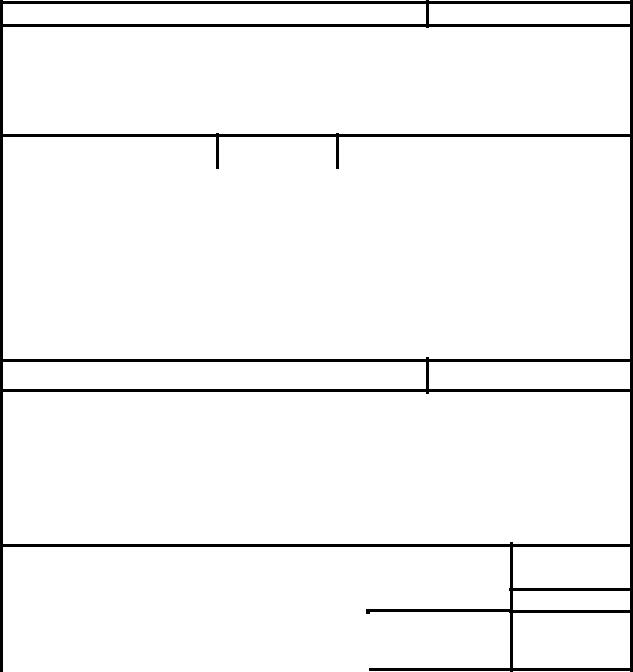
MODELING, SIMULATION AND PERFORMANCE ANALYSIS OF MIMO SYSTEMS WITH MULTICARRIER TIME DELAYS DIVERSITY MODULATION
.pdf
NAVAL
POSTGRADUATE
SCHOOL
MONTEREY, CALIFORNIA
THESIS
MODELING, SIMULATION AND PERFORMANCE ANALYSIS OF MULTIPLE-INPUT MULTIPLE-OUTPUT (MIMO) SYSTEMS WITH MULTICARRIER TIME DELAY DIVERSITY MODULATION
|
by |
|
Muhammad Shahid |
|
September 2005 |
Thesis Advisor: |
Frank Kragh |
Second Reader: |
Tri Ha |
Approved for public release; distribution is unlimited
THIS PAGE INTENTIONALLY LEFT BLANK

REPORT DOCUMENTATION PAGE |
Form Approved OMB No. 0704-0188 |
|
Public reporting burden for this collection of information is estimated to average 1 hour per response, including the time for reviewing instruction, searching existing data sources, gathering and maintaining the data needed, and completing and reviewing the collection of information. Send comments regarding this burden estimate or any other aspect of this collection of information, including suggestions for reducing this burden, to Washington headquarters Services, Directorate for Information Operations and Reports, 1215 Jefferson Davis Highway, Suite 1204, Arlington, VA 22202-4302, and to the Office of Management and Budget, Paperwork Reduction Project (0704-0188) Washington DC 20503.
1. AGENCY USE ONLY (Leave blank) 2. REPORT DATE 1. AGENCY USE ONLY (Leave blank)
September 2005
4. TITLE AND SUBTITLE: Modeling, Simulation and Performance Analysis |
5. FUNDING NUMBERS |
of Multiple-Input Multiple-Output (MIMO) Systems with Multicarrier Time |
|
Delay Diversity Modulation |
|
6. AUTHOR(S) Muhammad Shahid |
|
7. PERFORMING ORGANIZATION NAME(S) AND ADDRESS(ES) |
8. PERFORMING |
Naval Postgraduate School |
ORGANIZATION REPORT |
Monterey, CA 93943-5000 |
NUMBER |
9. SPONSORING /MONITORING AGENCY NAME(S) AND ADDRESS(ES) |
10. SPONSORING/MONITORING |
N/A |
AGENCY REPORT NUMBER |
|
|
11. SUPPLEMENTARY NOTES The views expressed in this thesis are those of the author and do not reflect the official policy or position of the Department of Defense or the U.S. Government.
12a. DISTRIBUTION / AVAILABILITY STATEMENT |
12b. DISTRIBUTION CODE |
Approved for public release; distribution is unlimited
13. ABSTRACT (maximum 200 words)
This thesis investigates the fundamentals of multiple-input single-output (MISO) and multiple-input multiple-output (MIMO) radio communication systems with space-time codes. A MISO system and MIMO systems were designed using multicarrier delay diversity modulation (MDDM). MDDM was incorporated with orthogonal frequency division multiplexing (OFDM). The design was implemented with binary phase shift keying (BPSK). Matlab was used to simulate the design, which was tested in both an additive white Gaussian noise (AWGN) channel and in a slow fading frequency nonselective multipath channel with AWGN. The receiver design was incorporated with the maximal ratio combiner (MRC) receiving technique with perfect knowledge of channel state information (CSI). The theoretical performance was derived for both channels and was compared with the simulated results.
14. SUBJECT TERMS Multiple-input Single-output (MISO), Multiple-input Multipleoutput (MIMO), Orthogonal Frequency Division Multiplexing (OFDM), Binary Phase Shift Keying, Rayleigh Fading Channel, Maximal Ratio Combining (MRC), Spatial Diversity
17. SECURITY |
18. SECURITY |
17. SECURITY |
CLASSIFICATION OF |
CLASSIFICATION OF THIS |
CLASSIFICATION OF |
REPORT |
PAGE |
REPORT |
Unclassified |
Unclassified |
Unclassified |
15.NUMBER OF PAGES
119
16.PRICE CODE
18. SECURITY CLASSIFICATION OF THIS PAGE
UL
NSN 7540-01-280-5500 |
Standard Form 298 (Rev. 2-89) |
|
Prescribed by ANSI Std. 239-18 |
i
THIS PAGE INTENTIONALLY LEFT BLANK
ii
Approved for public release; distribution is unlimited
MODELING, SIMULATION AND PERFORMANCE ANALYSIS OF MULTIPLE-INPUT MULTIPLE-OUTPUT (MIMO) SYSTEMS WITH MULTICARRIER DELAY DIVERSITY MODULATION (MDDM)
Muhammad Shahid
Squadron Leader, Pakistan Air Force
B.S., NED University Karachi, Pakistan, 1993
Submitted in partial fulfillment of the requirements for the degree of
MASTER OF SCIENCE IN ELECTRICAL ENGINEERING
from the
NAVAL POSTGRADUATE SCHOOL
September 2005
Author: |
Muhammad Shahid |
Approved by: |
Frank Kragh |
|
Thesis Advisor |
Tri Ha
Second Reader
Jeffrey B. Knorr
Chairman, Department of Electrical and Computer Engineering
iii
THIS PAGE INTENTIONALLY LEFT BLANK
iv
ABSTRACT
This thesis investigates the fundamentals of multiple-input single-output (MISO) and multiple-input multiple-output (MIMO) radio communication systems with spacetime codes. A MISO system and MIMO systems were designed using multicarrier delay diversity modulation (MDDM). MDDM was incorporated with orthogonal frequency division multiplexing (OFDM). The design was implemented with binary phase shift keying (BPSK). Matlab was used to simulate the design, which was tested in both an additive white Gaussian noise (AWGN) channel and in a slow fading frequency nonselective multipath channel with AWGN. The receiver design was incorporated with the maximal ratio combiner (MRC) receiving technique with perfect knowledge of channel state information (CSI). The theoretical performance was derived for both channels and was compared with the simulated results.
v
THIS PAGE INTENTIONALLY LEFT BLANK
vi
TABLE OF CONTENTS
I. |
INTRODUCTION........................................................................................................ |
1 |
||
|
A. |
BACKGROUND .............................................................................................. |
1 |
|
|
B. |
OBJECTIVE AND METHODOLOGY......................................................... |
2 |
|
|
C. |
RELATED RESEARCH................................................................................. |
2 |
|
|
D. |
THESIS ORGANIZATION............................................................................ |
2 |
|
II. |
MIMO SYSTEMS AND MULTICARRIER DELAY DIVERSITY ...................... |
5 |
||
|
A. |
MULTIPLE-INPUT MULTIPLE-OUTPUT (MIMO) SYSTEMS............. |
5 |
|
|
|
1. |
Single-Input Single-Output System.................................................... |
5 |
|
|
2. |
Single-Input Multiple-Output System................................................ |
6 |
|
|
3. |
Multiple-Input Single-Output System................................................ |
7 |
|
|
4. |
Multiple-Input Multiple-Output System ........................................... |
8 |
|
B. |
SPACE TIME CODING ............................................................................... |
12 |
|
|
C. |
MULTICARRIER DELAY DIVERSITY IN MIMO SYSTEMS............. |
13 |
|
|
D. |
ORTHOGONAL FREQUENCY DIVISION MULTIPLEXING ............. |
15 |
|
|
|
1. |
Generation of OFDM......................................................................... |
19 |
|
|
2. |
Cyclic Guard Interval........................................................................ |
20 |
|
E. THE MULTIPATH AND FADING CHANNEL........................................ |
21 |
||
|
|
1. |
Flat Rayleigh Fading Channel .......................................................... |
23 |
|
|
2. |
Maximal-Ratio Combining ............................................................... |
29 |
|
F. |
SUMMARY .................................................................................................... |
37 |
|
III.MULTICARRIER DELAY DIVERSITY MODULATION TRANSMITTER
AND RECEIVER MODELS .................................................................................... |
39 |
A.THE MULTICARRIER DELAY DIVERSITY MODULATION
|
SCHEME ........................................................................................................ |
39 |
|
B. |
MDDM TRANSMITTER ............................................................................. |
40 |
|
|
1. |
Binary Information Source and M PSK Modulator ...................... |
40 |
|
2. |
OFDM Modulator.............................................................................. |
40 |
|
3. |
Cyclic Delay Addition........................................................................ |
42 |
|
4. |
Guard Interval (Cyclic Prefix) Addition.......................................... |
42 |
|
5. |
Digital to Analog Conversion and RF Modulation ......................... |
43 |
C. |
MDDM RECEIVER ...................................................................................... |
43 |
|
D. |
SUMMARY .................................................................................................... |
47 |
|
IV. ANALYSIS AND SIMULATION OF MULTICARRIER DELAY |
|
||
DIVERSITY MODULATION SCHEME................................................................ |
49 |
||
A. SIMULATION OF MDDM TRANSMITTER............................................ |
51 |
||
B. SIMULATION OF MDDM RECIVER....................................................... |
52 |
||
C.SIMULATION AND PERFORMANCE ANALYSIS OF MDDM IN
AWGN............................................................................................................. |
53 |
1.Performance Analysis of MISO System with Two Transmit
and One Receive Antenna ................................................................. |
54 |
vii
2.Performance Analysis of MIMO System with Two Transmit
and Two Receive Antennas ............................................................... |
60 |
3.Performance Analysis of MIMO System with Two Transmit
and Three Receive Antennas............................................................. |
62 |
D.SIMULATION AND PERFORMANCE ANALYSIS OF MDDM IN A
MULTIPATH FADING CHANNEL ........................................................... |
65 |
1.Performance Analysis of MISO System with Two Transmit
and One Receive Antenna ................................................................. |
67 |
2.Performance Analysis of MIMO System with Two Transmit
|
|
and Two Receive Antennas ............................................................... |
72 |
|
3. |
Performance Analysis of MIMO System with Two Transmit |
|
|
|
and Three Receive Antennas............................................................. |
77 |
E. |
SUMMARY .................................................................................................... |
82 |
|
V. CONCLUSION .......................................................................................................... |
83 |
||
A. |
RESULTS ....................................................................................................... |
83 |
|
B. RECOMMENDATION FOR FUTURE RESEARCH............................... |
83 |
||
APPENDIX |
|
MATLAB CODES ............................................................................. |
85 |
A. SIMULATION OF THE MDDM IN AN AWGN CHANNEL.................. |
85 |
||
B.COMPUTING THEORETICAL BER OF THE MDDM IN AN
AWGN CHANNEL........................................................................................ |
87 |
C.SIMULATION OF THE MDDM IN FREQUENCY
NONSELECTIVE SLOW FADING RAYLEIGH CHANNEL ................ |
88 |
D.COMPUTING THEORETICAL BER OF THE MDDM IN
FREQUENCY NONSLECECTIVE SLOW FADING RAYLEIGH |
|
CHANNEL...................................................................................................... |
92 |
E.FUNCTIONS TO INTERPOLATE PROBABAILITY
DISTRIBUTION FUNCTIONS |
...................................................................93 |
LIST OF REFERENCES...................................................................................................... |
95 |
INITIAL DISTRIBUTION LIST ......................................................................................... |
99 |
viii
